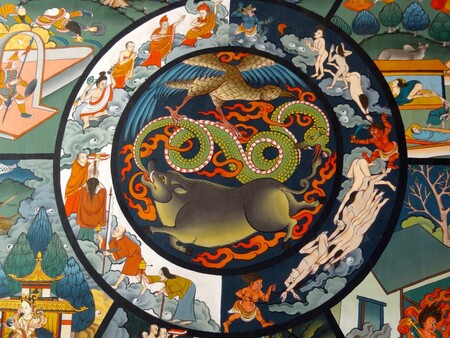What are the three poisons? (Greed, hatred, and delusion)

At the center of a Wheel of Life diagram, a rooster, a pig, and a snake represent the three poisons of greed, ignorance, and hatred, respectively. | Source: Alamy Stock Photo
In his early teachings, the Buddha identified “three poisons,” or three fires, or three negative qualities of the mind that cause most of our problems—and most of the problems in the world. The three poisons are: greed (raga, also translated as lust), hatred (dvesha, or anger), and delusion (moha, or ignorance). The three poisons are opposed by three wholesome, or positive attitudes essential to liberation: generosity (dana), lovingkindness (maitri, Pali: metta), and wisdom (prajna). Buddhist practice is directed toward the cultivation of these virtues and the reduction or destruction of the poisons; practitioners identify those thoughts that give rise to the three poisons and don’t dwell on them, while nurturing the thoughts that give rise to the three positive attitudes.
We don’t need to look far to see the three poisons at work. We see them every day in the news and in the streets, and if we pay attention, we can see them in our own mind and actions. The arising of these feelings may be outside our control—we don’t choose to be angry, for instance. But recognizing how greed, hatred, and delusion cause tremendous harm in the world can help us learn to manage them. Likewise, just as swallowing poison later causes sickness, nurturing these harmful attitudes leads to negative behaviors we will later regret.
Though commonly referred to as poisons, the Buddha first introduced these mental attitudes as fires in the Fire Sermon (Adittapariyaya Sutta): “Monks, all is burning . . . Burning with what? Burning with the fire of lust, with the fire of hate, with the fire of delusion.”
Fire is a central metaphor of Buddhism, typically as a negative quality of mind or consciousness. Putting out these fires is the goal of Buddhist practice. The word nirvana is derived from the extinguishing of fire. Sariputra, one of the Buddha’s chief disciples, was once asked, “What is nirvana?” He answered, “The destruction of greed, the destruction of anger, the destruction of delusion—this is nirvana.”
The three poisons are depicted at the center of the Wheel of Life (bhavachakra), a visual representation of the sorrows of samsara. Greed is depicted as a rooster, hatred as a snake, and delusion as a pig. Importantly, they literally feed off one another; each animal consuming the tail end of the other in a vicious cycle of delusion. The centrality of the three poisons demonstrates their role in powering the cycle of birth, death, and rebirth, the escape from which is nirvana.

Tricycle is more than a magazine
Gain access to the best in sprititual film, our growing collection of e-books, and monthly talks, plus our 25-year archive
Subscribe now